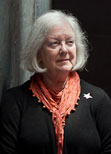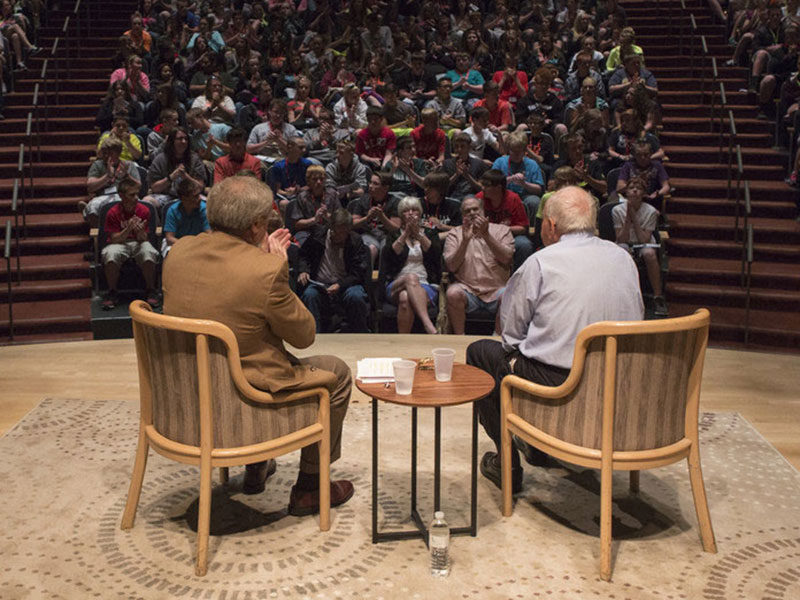June 25, 2008
Louise Lawrence-Israëls shares memories from her early childhood spent hiding in Amsterdam. In 1942, six-month-old Louise and her family went into hiding on the fourth floor of a rowhouse, where they remained until the end of the war in 1945.
LISTEN
Esta página también está disponible en español.
TRANSCRIPT
LOUISE LAWRENCE-ISRAËLS:
My mom, my dad, and Selma were always in fear. They must have gone through a terrible time. But they wanted the children to not feel that. They really shielded us. So a birthday party for a second year old was important for them.
NARRATOR:
Over 60 years after the Holocaust, hatred, antisemitism, and genocide still threaten our world. The life stories of Holocaust survivors transcend the decades and remind us of the constant need to be vigilant citizens and to stop injustice, prejudice, and hatred wherever and whenever they occur.
This podcast series presents excerpts of interviews with Holocaust survivors from the United States Holocaust Memorial Museum’s public program First Person: Conversations with Holocaust Survivors.
In today’s episode Louise Lawrence-Israëls talks with guest host Dr. Patricia Heberer about memories of her early childhood spent in hiding on the fourth floor of a rowhouse in Amsterdam.
PATRICIA HEBERER:
You were very young at this point, but what do you remember? I know very well that you remember your second birthday.
LOUISE LAWRENCE-ISRAËLS:
Yes.
PATRICIA HEBERER:
What are your general memories of this time period?
LOUISE LAWRENCE-ISRAËLS:
Right, as strange as it sounds, I have very strong memories about certain things. There are actually two things I’d like to share. When we went into hiding, my parents told my two-year-old brother at that time, “Never leave your sister alone.”
They were dreaming that if we would be betrayed and we would be separated, that the two children should always be together. My brother was such a good boy and he took that so seriously that he took my hand all the time—he held my hand all the time.
When I started walking, we walked hand in hand. When I went to the bathroom, he held my hand. When we went to sleep, he made me stick my arm through the slats of my crib and he held my hand. Of course, then you fall asleep and you both relax, but I remember that.
And if somebody gives me a very strong handshake, that memory comes back, because the few times that we were afraid, he used to really squeeze my hand. That was the only way. We didn’t cry, we didn’t say anything, but he used to just squeeze my hand.
The other memory is that we had floor covering, but not nice and soft like this carpet here. If you take a coconut, and you take the outside of a coconut and you go over it with your hands, the rough fibers can hurt your hands.
So the mats were woven from coconut fibers together. I was six months old when we went into hiding and maybe I was ten months old when I started to stand up, and what do you do as parents with a little child that stands up? You say, “Come, walk to me.”
Now also, I was always on bare feet. My mom could not take me to a shoe store because we never went out. If there were still stores with shoes, she couldn’t take me to it, so I had to learn to walk on my bare feet.
So, “Come to me, come to me,” and I used to, one step forward, a second step forward. My feet hurt on those mats. I didn’t like it so I used to sit down and I probably thought, “You go walk on these mats, but I’m not going to do it.”
Of course then, my brother with his hand, came up and he made me walk later on so I learned to walk on it, but even today, walking on sand on a beach or anything, I don’t like it. It’s rough and that whole thing with the coconut mats comes to mind and it’s really a vivid memory.
And the other memory that you just elaborated on is my second birthday. My mom, my dad, and our friend Selma wanted it to be a very special day for me, and they really worked on it. I also have to explain that my mom, my dad, and Selma were always in fear.
They must have gone through a terrible time, but they wanted the children to not feel that. They really shielded us. So a birthday party for a second-year-old was important for them. Just before my birthday, a friend of my dad’s had come across a little doll’s chair.
And he asked my dad, he said, “Is that something for your daughter?” and my dad was so happy. He said, “It’s going to be her second birthday. Yes, I would like to have it.” So the friend brought it over and he brought a camera and said, “We need to take pictures. It’s going to be your second birthday.”
We found those pictures after the war. He could never leave the pictures with us because then, God forbid, you were ever found out and there would be questions, so we found the pictures after the war.
But he also said, “If we take pictures, she needs to have shoes on,” so he brought over shoes and they were two sizes too small, so my feet were squeezed into the shoes for the picture. But my mom, out of an old blouse, had made a beautiful dress—all handmade with tiny little elephants on it. It was one of her blouses.
Our friend Selma made a doll, a rag doll, out of really old rags. The face was an old stocking and she made eyes; one eye was a little droopy. My brother had a pull-horse—maybe you remember from seeing that in the picture.
I was allowed to play with that all day. It was really special. I didn’t have to ask him. For that day, it was my pull-horse. But the doll, I really unpacked, and then I saw the chair. I was only two years old, and it was a doll’s chair, but I sat in it and I was so happy! So here’s the picture with me sitting in it.
The chair had a different life. My brother and I used the chair for everything. When we were angry at each other, we threw the chair at each other. If we needed to step up on something, we used the chair as a stepladder. You name it, what we did.
So the chair, at the end of the war, was still there, but there were some parts that were missing, so in 1948, my mom had the chair restored. The chair was in the family all the years. When we used to visit Holland with our daughters, they played with it.
The chair finally came here. We did a lot of moving, so I left the chair in Holland for many years. When the chair came here, I asked our children if they wanted it for their children, our grandchildren.
The chair was fragile, so they said, “Mom, maybe better not. You keep it.” What am I going to do with a doll’s chair forever? So I donated the chair to the Museum, so it’s here right now, and it’s a good place for it. I’m really happy.
NARRATOR:
You have been listening to First Person: Conversations with Holocaust Survivors, a podcast series of the United States Holocaust Memorial Museum. Every Wednesday at 1 p.m. from March through August, Holocaust survivors share their stories during First Person programs held at the Museum in Washington, DC. We would appreciate your feedback on this series. [Please take our First Person podcast survey and let us know what you think.]
[On] our website you can also learn more about the Museum’s survivors, listen to the complete recordings of their conversations, and listen to the Museum podcasts Voices on Antisemitism and Voices on Genocide Prevention.


